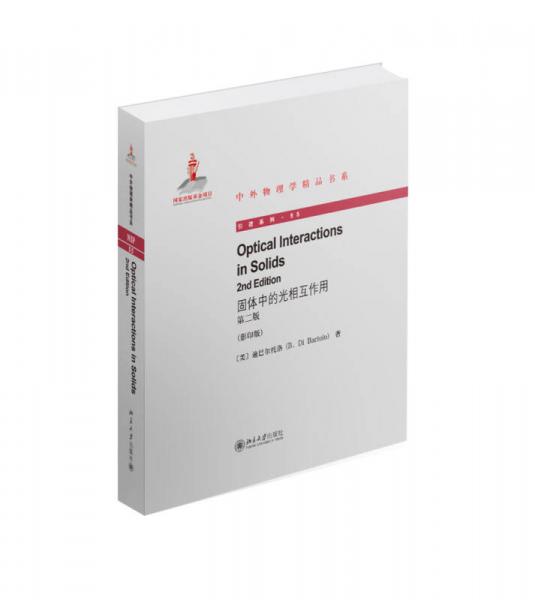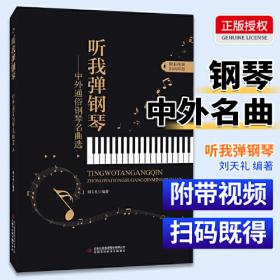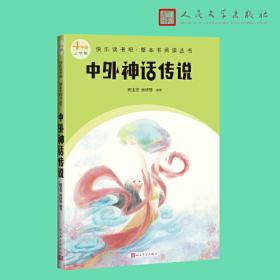中外物理学精品书系:固体中的光相互作用 (第二版 英文影印版)
作者:
[美] 迪巴尔托洛
(B. Di Bartolo) 著
出版时间:
2015-01
版次:
1
ISBN:
9787301251720
定价:
107.00
装帧:
平装
开本:
16开
纸张:
胶版纸
页数:
636页
字数:
635千字
-
《中外物理学精品书系:固体中的光相互作用 (第二版 英文影印版)》系统而全面地介绍了固体光特性的一些原理。本书为在固体材料吸收和荧光光谱领域,及激光领域工作的科研人员提供了详实的理论背景。通过群论这一工具,以及对于对称性的讨论,本书统一地阐述了辐射场的量子理论、分子热振动、晶体、共价键等内容。
《中外物理学精品书系:固体中的光相互作用 (第二版 英文影印版)》既适合科研人员参考,也适合研究生和高水平本科生阅读。 (美)迪巴尔托洛,美国波士顿学院教授。 PrefacetotheSecondEditionvii
1.ElementsofQuantumMechanics1
1.ReviewofClassicalMechanics................1
2.VectorSpacesandLinearOperators............4
3.BasicPostulatesofQuantumMechanics..........10
4.CompatibleObservablesandCompleteSet
ofCommutingOperators...................13
5.FormoftheOperators....................15
6.MatrixFormalismandTransformationTheory.......20
7.GeneralTheoryofAngularMomentum...........29
8.Time-IndependentPerturbationTheory..........35
9.Time-DependentPerturbationTheory...........42
References...........................48
2.ElementsofGroupTheory49
1.PropertiesofaGroup.....................49
2.Classes.............................51
3.TheoryofRepresentations..................53
4.Schur'sLemmaandOrthogonalityRelations........58
5.CharactersofaGroup....................61
6.PropertiesoftheIrreducibleRepresentations
ofaGroup...........................64
7.TheDirectProductRepresentation.............65
8.ProductGroupsandTheirRepresentations........66
9.SummaryofRules......................68
10.GroupsofRealOrthogonalMatrices............69
11.SpaceGroupsandSymmetryofCrystallineSolids.....75
12.TheIrreducibleRepresentationsofaGroupofPrimitive
Translations..........................92
13.TheIrreducibleRepresentationsofSpaceGroups.....95
References...........................113
3.ConnectionofQuantumMechanicswith
GroupTheory115
1.TheEffectofanOrthogonalCoordinateTransformationon
theVectorsofaHilbertSpace................115
2.TheSymmetryGroupoftheSchr¨odingerEquation....117
3.TheFundamentalTheoremforFunctions
andOperatorsTransformingIrreducibly..........121
4.TheConstructionofFunctionsTransforming
Irreducibly...........................124
5.TheFullRotationalGroupandtheQuantumTheory
ofAngularMomentum....................127
6.TheSpinoftheElectronandtheDoubleValued
Representations........................137
7.TheKramers'Degeneracy..................142
8.TheSymmetricGroupoftheHamiltonianandthePauli
Principle............................148
References...........................154
4.TheHydrogenAtom155
1.TheUnperturbedHamiltonian................155
2.TheSpin-OrbitInteraction..................157
3.TheZeemanInteraction...................160
4.GroupTheoreticalConsiderationsfortheHAtom.....162
References...........................164
5.TheComplexAtom:MultipletTheory165
1.TheHeliumAtom.......................165
2.TheManyElectronAtom..................169
3.GroupTheoreticalConsiderationsforaComplexAtom..176
4.TheEnergiesofSpectralTerms...............180
5.Hund'sRulesandthePrincipleofEquivalence
ofElectronsandHoles....................188
6.TheSpin-OrbitSplittingofTerms..............190
7.AnExampleofSpin-OrbitandZeemanSplitting.....193
References...........................195
6.TheMagneticIoninaCrystal:TheRoleofSymmetry197
1.BondinginCrystals......................197
2.TheIonicBondinCrystals.................198
3.ElectronicConfigurationsandProperties
ofMagneticIons.......................201
4.TheCrystallineFieldHypothesis..............212
References...........................216
7.TheWeakFieldScheme217
1.TheHamiltonianoftheFreeIon..............217
2.TheCrystalFieldPerturbation...............218
3.ApplicationoftheWeakFieldScheme...........219
4.SplittingsofJLevelsinFieldsofDifferent
Symmetries..........................223
References...........................223
8.TheMediumFieldScheme225
1.TheHamiltonianoftheFreeIon..............225
2.TheCrystalFieldPerturbation...............227
3.TheSpin-OrbitInteraction..................228
4.AnApplicationoftheMediumFieldScheme........228
5.TheMethodofOperatorEquivalents:TheSplittingof
TransitionMetalIonsLevelsinanOctahedral
CrystalField.........................230
References...........................235
9.TheStrongFieldScheme237
1.TheUnperturbedHamiltonian................237
2.TheCrystalFieldPerturbation...............239
3.TheElectrostaticInteraction.................240
4.TheSpin-OrbitInteraction..................241
10.CovalentBondingandItsEffectonMagnetic
IonsinCrystals243
1.TheRelevanceofCovalentBonding.............243
2.TheFormationofMolecularOrbitals............244
3.ExampleofMolecularOrbitalsFormation.........246
4.TheUseofProjectionOperatorsintheConstruction
ofMolecularOrbitals.....................258
5.TheFormationofHybrids..................262
6.HybridsoftheCentralIoninaTetrahedral
ComplexAB4.........................267
7.HybridsoftheCentralIoninanOctahedral
ComplexAB6.........................269
8.TheCombinationsofLigandOrbitalsinan
ABnComplex.........................271
9.TheEnergyLevelsofanABnComplex...........274
References...........................282
11.TheQuantumTheoryoftheRadiationField283
1.TheClassicalElectromagneticField.............283
2.TheQuantumTheoryoftheElectromagneticField....286
12.MolecularVibrations295
1.TheClassicalTheoryofMolecularVibrations.......295
2.TheSymmetryoftheMoleculesandthe
NormalCoordinates.....................299
3.HowtoFindtheNormalModesofVibration........300
4.TheUseofSymmetryCoordinates.............303
5.TheQuantumTheoryofMolecularVibrations.......307
6.TheSelectionRulesforInfraredandRamanTransitions,
TheFermiResonance.....................309
7.TheNormalModesandtheSymmetryCoordinates
ofaTetrahedralComplexAB4...............312
8.TheNormalModesandtheSymmetryCoordinates
ofanOctahedralComplexAB6...............315
References...........................321
13.LatticeVibrations323
1.TheGeometryofCrystallineSolids.............323
2.LatticeVibrationsofanInfiniteCrystalwith
OneAtomPerUnitCell...................326
3.LatticeVibrationsofaFiniteCrystalwith
OneAtomPerUnitCell...................329
4.LatticeVibrationsofaCrystalwithMoreThan
OneAtomPerUnitCell...................336
5.ThermodynamicsofPhonons................339
6.PhononsandPhotons.SimilaritiesandDifferences....346
References...........................347
14.TheIon-PhotonInteraction:Absorptionand
EmissionofRadiation349
1.TheIon-RadiationInteraction................349
2.TheExpansionoftheInteractionHamiltonian:
DifferentTypesofRadiation.................351
3.TheDensityofFinalStates.................353
4.TheTransitionProbabilityPerUnitTime.........354
5.DipoleRadiation.......................356
6.SelectionRulesforRadiativeTransitions..........358
7.AbouttheIntensitiesofRadiativeTransitions.......369
8.TheStaticEffectsoftheInteractionBetween
anAtomicSystemandtheElectromagneticField.....373
References...........................374
15.TheJudd-OfeltTheory375
1.Motivation...........................375
2.GeneralConsiderations....................376
3.TheTheory..........................377
4.Applications..........................381
References...........................382
16.TheIon-VibrationInteraction.Radiationless
Processes,ThermalShift,andBroadening
ofSharpLines385
1.TheIon-VibrationInteraction................385
2.RadiationlessProcessesinCrystals.............387
3.DifferentTypesofLineBroadeningMechanisms:
LorentzianandGaussianLineShapes............402
4.TheoryofThermalBroadeningofSharpLines.......413
5.TheoryofThermalLineShift................418
References...........................423
17.Vibrational-ElectronicInteractionandSpectra425
1.Introduction..........................425
2.Ion-VibrationInteractioninMolecularComplexes.....425
3.VibronicSpectraofMolecularComplexes.........427
4.SpaceGroupsandLatticeVibrations............438
5.LatticeAbsorptioninPerfectCrystals...........445
6.PhononActivationDuetoImpurityIons
inPerfectCrystals......................447
7.SelectionRulesforVibronicTransitionsDue
toMagneticImpuritiesinCrystals.............450
References...........................452
18.EnergyTransferAmongIonsinSolids455
1.Quantum-MechanicalTreatmentoftheInteractions
AmongAtoms.........................455
2.DifferentTypesofInteractions................469
3.ModesofExcitationandTransfer..............478
4.EnergyTransferwithNoMigrationofExcitation
AmongDonors........................482
5.EnergyTransferwithMigrationofExcitation
AmongDonors........................495
References...........................514
19.AbsorptionSpectraofMagneticIonsinCrystals517
1.TheAandBCoefficientsasRelatedtoMagneticIons
inCrystals...........................517
2.GeneralPropertiesofAbsorptionSpectra.........520
3.AbsorptionSpectraofMagneticIonsinCrystals......526
4.TheEffectsofTemperatureonAbsorptionSpectra....532
5.ExcitedStateAbsorption...................541
References...........................544
20.FluorescenceSpectraofMagneticIonsinCrystals547
1.TheFluorescenceEmissionofMagneticIonsUnder
ContinuousExcitation....................547
2.TheResponseofFluorescentSystems
toTransientExcitation....................553
3.GeneralPropertiesoftheFluorescenceDecays
inaMultilevelSystem....................558
4.InteractionsofMagneticIonsandTheirEffects
ontheFluorescenceOutput.................562
5.TheFactorsAffectingtheFluorescenceEmission.....564
6.FluorescenceofMagneticIonsinCrystals.........573
References...........................578
21.ElementsofLaserTheory583
1.LaserConditions.......................583
2.ExamplesofIonicSolidStateLasers............598
References...........................605
SubjectIndex607
-
内容简介:
《中外物理学精品书系:固体中的光相互作用 (第二版 英文影印版)》系统而全面地介绍了固体光特性的一些原理。本书为在固体材料吸收和荧光光谱领域,及激光领域工作的科研人员提供了详实的理论背景。通过群论这一工具,以及对于对称性的讨论,本书统一地阐述了辐射场的量子理论、分子热振动、晶体、共价键等内容。
《中外物理学精品书系:固体中的光相互作用 (第二版 英文影印版)》既适合科研人员参考,也适合研究生和高水平本科生阅读。
-
作者简介:
(美)迪巴尔托洛,美国波士顿学院教授。
-
目录:
PrefacetotheSecondEditionvii
1.ElementsofQuantumMechanics1
1.ReviewofClassicalMechanics................1
2.VectorSpacesandLinearOperators............4
3.BasicPostulatesofQuantumMechanics..........10
4.CompatibleObservablesandCompleteSet
ofCommutingOperators...................13
5.FormoftheOperators....................15
6.MatrixFormalismandTransformationTheory.......20
7.GeneralTheoryofAngularMomentum...........29
8.Time-IndependentPerturbationTheory..........35
9.Time-DependentPerturbationTheory...........42
References...........................48
2.ElementsofGroupTheory49
1.PropertiesofaGroup.....................49
2.Classes.............................51
3.TheoryofRepresentations..................53
4.Schur'sLemmaandOrthogonalityRelations........58
5.CharactersofaGroup....................61
6.PropertiesoftheIrreducibleRepresentations
ofaGroup...........................64
7.TheDirectProductRepresentation.............65
8.ProductGroupsandTheirRepresentations........66
9.SummaryofRules......................68
10.GroupsofRealOrthogonalMatrices............69
11.SpaceGroupsandSymmetryofCrystallineSolids.....75
12.TheIrreducibleRepresentationsofaGroupofPrimitive
Translations..........................92
13.TheIrreducibleRepresentationsofSpaceGroups.....95
References...........................113
3.ConnectionofQuantumMechanicswith
GroupTheory115
1.TheEffectofanOrthogonalCoordinateTransformationon
theVectorsofaHilbertSpace................115
2.TheSymmetryGroupoftheSchr¨odingerEquation....117
3.TheFundamentalTheoremforFunctions
andOperatorsTransformingIrreducibly..........121
4.TheConstructionofFunctionsTransforming
Irreducibly...........................124
5.TheFullRotationalGroupandtheQuantumTheory
ofAngularMomentum....................127
6.TheSpinoftheElectronandtheDoubleValued
Representations........................137
7.TheKramers'Degeneracy..................142
8.TheSymmetricGroupoftheHamiltonianandthePauli
Principle............................148
References...........................154
4.TheHydrogenAtom155
1.TheUnperturbedHamiltonian................155
2.TheSpin-OrbitInteraction..................157
3.TheZeemanInteraction...................160
4.GroupTheoreticalConsiderationsfortheHAtom.....162
References...........................164
5.TheComplexAtom:MultipletTheory165
1.TheHeliumAtom.......................165
2.TheManyElectronAtom..................169
3.GroupTheoreticalConsiderationsforaComplexAtom..176
4.TheEnergiesofSpectralTerms...............180
5.Hund'sRulesandthePrincipleofEquivalence
ofElectronsandHoles....................188
6.TheSpin-OrbitSplittingofTerms..............190
7.AnExampleofSpin-OrbitandZeemanSplitting.....193
References...........................195
6.TheMagneticIoninaCrystal:TheRoleofSymmetry197
1.BondinginCrystals......................197
2.TheIonicBondinCrystals.................198
3.ElectronicConfigurationsandProperties
ofMagneticIons.......................201
4.TheCrystallineFieldHypothesis..............212
References...........................216
7.TheWeakFieldScheme217
1.TheHamiltonianoftheFreeIon..............217
2.TheCrystalFieldPerturbation...............218
3.ApplicationoftheWeakFieldScheme...........219
4.SplittingsofJLevelsinFieldsofDifferent
Symmetries..........................223
References...........................223
8.TheMediumFieldScheme225
1.TheHamiltonianoftheFreeIon..............225
2.TheCrystalFieldPerturbation...............227
3.TheSpin-OrbitInteraction..................228
4.AnApplicationoftheMediumFieldScheme........228
5.TheMethodofOperatorEquivalents:TheSplittingof
TransitionMetalIonsLevelsinanOctahedral
CrystalField.........................230
References...........................235
9.TheStrongFieldScheme237
1.TheUnperturbedHamiltonian................237
2.TheCrystalFieldPerturbation...............239
3.TheElectrostaticInteraction.................240
4.TheSpin-OrbitInteraction..................241
10.CovalentBondingandItsEffectonMagnetic
IonsinCrystals243
1.TheRelevanceofCovalentBonding.............243
2.TheFormationofMolecularOrbitals............244
3.ExampleofMolecularOrbitalsFormation.........246
4.TheUseofProjectionOperatorsintheConstruction
ofMolecularOrbitals.....................258
5.TheFormationofHybrids..................262
6.HybridsoftheCentralIoninaTetrahedral
ComplexAB4.........................267
7.HybridsoftheCentralIoninanOctahedral
ComplexAB6.........................269
8.TheCombinationsofLigandOrbitalsinan
ABnComplex.........................271
9.TheEnergyLevelsofanABnComplex...........274
References...........................282
11.TheQuantumTheoryoftheRadiationField283
1.TheClassicalElectromagneticField.............283
2.TheQuantumTheoryoftheElectromagneticField....286
12.MolecularVibrations295
1.TheClassicalTheoryofMolecularVibrations.......295
2.TheSymmetryoftheMoleculesandthe
NormalCoordinates.....................299
3.HowtoFindtheNormalModesofVibration........300
4.TheUseofSymmetryCoordinates.............303
5.TheQuantumTheoryofMolecularVibrations.......307
6.TheSelectionRulesforInfraredandRamanTransitions,
TheFermiResonance.....................309
7.TheNormalModesandtheSymmetryCoordinates
ofaTetrahedralComplexAB4...............312
8.TheNormalModesandtheSymmetryCoordinates
ofanOctahedralComplexAB6...............315
References...........................321
13.LatticeVibrations323
1.TheGeometryofCrystallineSolids.............323
2.LatticeVibrationsofanInfiniteCrystalwith
OneAtomPerUnitCell...................326
3.LatticeVibrationsofaFiniteCrystalwith
OneAtomPerUnitCell...................329
4.LatticeVibrationsofaCrystalwithMoreThan
OneAtomPerUnitCell...................336
5.ThermodynamicsofPhonons................339
6.PhononsandPhotons.SimilaritiesandDifferences....346
References...........................347
14.TheIon-PhotonInteraction:Absorptionand
EmissionofRadiation349
1.TheIon-RadiationInteraction................349
2.TheExpansionoftheInteractionHamiltonian:
DifferentTypesofRadiation.................351
3.TheDensityofFinalStates.................353
4.TheTransitionProbabilityPerUnitTime.........354
5.DipoleRadiation.......................356
6.SelectionRulesforRadiativeTransitions..........358
7.AbouttheIntensitiesofRadiativeTransitions.......369
8.TheStaticEffectsoftheInteractionBetween
anAtomicSystemandtheElectromagneticField.....373
References...........................374
15.TheJudd-OfeltTheory375
1.Motivation...........................375
2.GeneralConsiderations....................376
3.TheTheory..........................377
4.Applications..........................381
References...........................382
16.TheIon-VibrationInteraction.Radiationless
Processes,ThermalShift,andBroadening
ofSharpLines385
1.TheIon-VibrationInteraction................385
2.RadiationlessProcessesinCrystals.............387
3.DifferentTypesofLineBroadeningMechanisms:
LorentzianandGaussianLineShapes............402
4.TheoryofThermalBroadeningofSharpLines.......413
5.TheoryofThermalLineShift................418
References...........................423
17.Vibrational-ElectronicInteractionandSpectra425
1.Introduction..........................425
2.Ion-VibrationInteractioninMolecularComplexes.....425
3.VibronicSpectraofMolecularComplexes.........427
4.SpaceGroupsandLatticeVibrations............438
5.LatticeAbsorptioninPerfectCrystals...........445
6.PhononActivationDuetoImpurityIons
inPerfectCrystals......................447
7.SelectionRulesforVibronicTransitionsDue
toMagneticImpuritiesinCrystals.............450
References...........................452
18.EnergyTransferAmongIonsinSolids455
1.Quantum-MechanicalTreatmentoftheInteractions
AmongAtoms.........................455
2.DifferentTypesofInteractions................469
3.ModesofExcitationandTransfer..............478
4.EnergyTransferwithNoMigrationofExcitation
AmongDonors........................482
5.EnergyTransferwithMigrationofExcitation
AmongDonors........................495
References...........................514
19.AbsorptionSpectraofMagneticIonsinCrystals517
1.TheAandBCoefficientsasRelatedtoMagneticIons
inCrystals...........................517
2.GeneralPropertiesofAbsorptionSpectra.........520
3.AbsorptionSpectraofMagneticIonsinCrystals......526
4.TheEffectsofTemperatureonAbsorptionSpectra....532
5.ExcitedStateAbsorption...................541
References...........................544
20.FluorescenceSpectraofMagneticIonsinCrystals547
1.TheFluorescenceEmissionofMagneticIonsUnder
ContinuousExcitation....................547
2.TheResponseofFluorescentSystems
toTransientExcitation....................553
3.GeneralPropertiesoftheFluorescenceDecays
inaMultilevelSystem....................558
4.InteractionsofMagneticIonsandTheirEffects
ontheFluorescenceOutput.................562
5.TheFactorsAffectingtheFluorescenceEmission.....564
6.FluorescenceofMagneticIonsinCrystals.........573
References...........................578
21.ElementsofLaserTheory583
1.LaserConditions.......................583
2.ExamplesofIonicSolidStateLasers............598
References...........................605
SubjectIndex607
查看详情
-
九品
安徽省阜阳市
平均发货14小时
成功完成率93.64%
-
九品
-
九五品
湖北省武汉市
平均发货25小时
成功完成率79.13%
-
九五品
河北省廊坊市
平均发货1小时
成功完成率98.96%
-
九五品
北京市通州区
平均发货29小时
成功完成率82.71%
-
九品
北京市海淀区
平均发货24小时
成功完成率83.31%
-
九品
北京市昌平区
平均发货23小时
成功完成率88.64%
-
九品
北京市东城区
平均发货25小时
成功完成率89.25%
-
九品
北京市海淀区
平均发货23小时
成功完成率89.78%
-
九五品
上海市青浦区
平均发货23小时
成功完成率66.67%

 占位居中
占位居中























